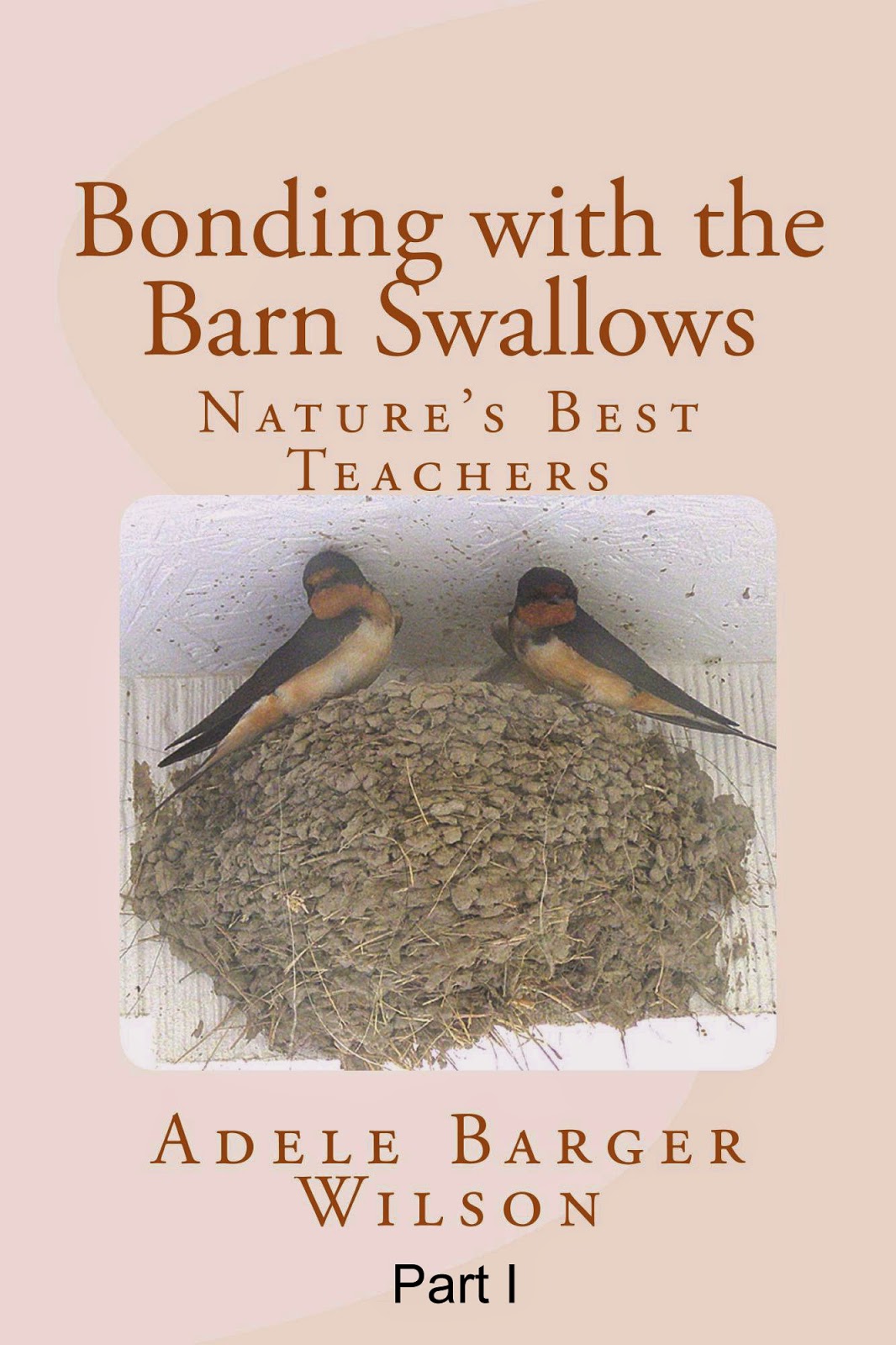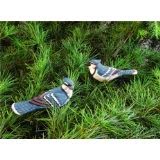
by Adele Barger Wilson, author of
Bonding with the Barn Swallows
Photos and text © 2014 Adele Wilson
At sunrise this morning it was 14 degrees F (-10 C). Ice was clinging to the insides of my storm windows. I opened my door and was greeted by ice -- icy air, icy porch, icy car, and heavy frost on the lawn.
 |
| Porch nest, November 11, 2014 |
There is an old swallow nest on an eave of my porch. It was originally a Barn Swallow nest, but now it is a Cliff Swallow nest. The nest is generally visible from the inside of my storm
door as I look toward the porch. To see the nest, all I have to do is look up and to the
right, and it is only 4 feet away. (You can read more
about the nest at
http://www.deerkisshollowjewelry.com/barn-swallows.htm.)
Did you know that some types of birds need to find warm, enclosed
spaces in which to roost on cold winter nights? Bluebirds, for
instance, will often roost in the same nesting boxes that they used
during the previous summer. During the winter, Bluebirds do not stay
inside the boxes during the day, as they did during the summer while
they were incubating eggs and raising their young. Instead, they enter
their roosting spaces at sunset and depart at daybreak.
Last winter, a pair of Carolina Wrens spent nights in my porch nest in order to keep warm. Around sunset, I would sometimes observe a Wren on the porch, obviously waiting for me to go inside and give it clearance to fly to the nest. On a couple of occasions, I peeked outside my door at daybreak and saw a Wren fly from the nest.
By April the Carolina Wrens were gone. I no longer saw them at the suet feeders or in the driveway. Where did they go? I suppose they relocated somewhere to build their nest and raise their young. All I know is that I have missed them and wondered if they are still all right.
A MORNING SURPRISE!
Back to this morning: Since it was so cold this morning, I wondered if any birds had roosted in the nest last night. The glass on the inside of my storm door was foggy. The cold temperature outdoors had caused moisture condensation, rendering it impossible for me to see outside my storm door without opening it.
When I opened my door, I immediately looked up at the nest. Just a couple of seconds later, a Carolina Wren peeked out of the nest's entrance hole!!! Upon seeing me, he quickly took flight.
What a thrill to know that the nest is again being used as a roosting place! I am assuming that it was the male Carolina Wren that I saw leaving the nest this morning. The female may well have still been inside the nest.
Presumably the same pair of Wrens that used the nest last winter have returned. Birds tend to be habitual, returning to the same locations for the same purposes year after year.
MY INTRODUCTION TO CAROLINA WRENS
The first time I ever saw a Wren in the nest, I didn't even know it was a Wren! It was on a very cold evening in early March 2013. I had gone grocery shopping after work and had finally arrived home. After carrying my first load of groceries inside, I proceeded to open my door to get the second load. At that moment, I looked up and was shocked to see a bird go inside the nest. The bird looked like a sparrow, but it had a white line over its eye and a very long beak.
It was the long beak that stumped me. I had never seen that long of a beak on a small bird.
As I stared at the nest, I saw the bird exit and fly out of sight.
What kind of bird was it and what was it doing in the nest? It was a very cold night in March, still snow season here in the mountains. Do birds start nesting here that early in the year? By that time, darkness had fallen. I turned on the porch light, stepped outside, looked up at the nest, and wondered what type of bird would lay eggs during cold winter weather.
My curiosity got the best of me. I returned inside and got a step ladder and a mirror. Once I had returned to the porch and set up the step ladder, I climbed up, mirror in hand, to look inside the nest. This was how I had checked for Barn Swallow eggs during the summer of 2012. I was about to put the mirror above the nest, when, suddenly, there was a loud flapping noise and something swooped out of the nest and away from the porch! It all occurred in a matter of seconds and scared me so much that I was shaking. I almost fell off the ladder.
I went back inside to calm down and began looking through my bird book. After studying the drawings for a while, I concluded the bird that I had seen entering and exiting the nest had been a Wren.
The Wren's mate must have still been inside the nest when I saw the first Wren leave. I had apparently disturbed both Wrens and felt exceedingly guilty.
After further research based on the time of year, I determined that the bird had been a Carolina Wren rather than a House Wren. In this region of the country we have Carolina Wrens year-round, but House Wrens only during the summer.
I was both excited and concerned at the same time. The nest had been built by Barn Swallows two years previously and used by them during both summers. Were the Wrens going to use the nest to start a family? If so, what was going to happen when the Barn Swallows return in mid-April? Would the Wrens be finished using the nest?
I saw no more Wrens that year. The Barn Swallows returned in mid April, but did not use the nest. Cliff Swallows ended up refurbishing the nest that summer. I have narrated that story on my other blog at
http://www.deerkisshollowjewelry.com/barn-swallows.htm.
In August of that year, all of our swallows, both Barn and Cliff, left
the area for their winter migration. The porch nest was still intact,
only now it looked like a Cliff Swallow nest. The photo to the right
shows what the nest looked like on July 16, 2013.
JANUARY 2014
Summer turned to fall, and fall turned to winter. It was now January 2014.
One afternoon in January, a heavy snowstorm had come though our area, leaving almost 12 inches of accumulation. The snowfall ended around 5 p.m., when my next-door neighbor and I proceeded to shovel snow from the porch that we share. After we had cleared the porch, it was starting to get dark, but there was still the driveway to do. As we began working on the driveway, my other next-door neighbor, who was still inside her apartment, called to me and told me that she had seen a bird fly into the swallow nest.
Curious and excited, I ran up the stairs and toward the nest. As I was nearing the nest, a bird flew out of it and landed on the lower roof of our building. I could tell it was a Carolina Wren!
I proceeded back to the driveway to join with my neighbor in the shoveling effort. About 30 minutes later, darkness had fallen. The neighbor who was still inside her apartment again called to me, "Adele, I just saw two birds fly into the nest!"
That night, after much research, I learned that Carolina Wrens need to find warm, enclosed spaces to spend cold winter nights. It made sense. That was why the Wrens were trying to use the nest that night in March 2013 -- until I scared them, that is!
 |
| Carolina Wren waiting for me go inside |
Several weeks later, on March 1, 2014, I was in the driveway with my camera, taking pictures of birds at the feeder. All of a sudden, a bird flew onto the porch rail and started scolding me. Fortunately, this time I recognized the bird and understood what he was telling me!
It was the Carolina Wren again, and he was telling me to get inside so that he could fly to the nest. He kindly allowed me take his picture, after which I returned inside my apartment and closed the door.
 |
| Close-up of Carolina Wren |
But I couldn't resist peeking out through the blinds and storm door. I saw the male Wren fly to the nest. But he did not go inside the nest! He clung to the outside of the entrance hole. Soon a second Wren flew to the nest and quickly entered it. At that point the first Wren also entered the nest.
How chivalrous, I thought! Upon seeing that the way was clear, the male Wren had flown to the nest, and then had guarded the entrance so that the female could enter! After the female had been safe inside the nest, the male had joined her.
I am so happy that the porch nest is again
being used this winter!
Update, November 26, 2014:
Late this afternoon, just before sunset, the pair of Carolina Wrens was
hanging around the porch area. I saw them first in the nearby barberry
bush. A Mockingbird soon flew from The Mockingbird Tree into the shrub. Oh no, I thought, have
the Mockingbirds taken over that bush, too?
[The
Mockingbirds have their own tree now, which I term "The Mockingbird
Tree". More information about my battles with the Mockingbirds can be
found at:
Adventures in Bird Feeding, Part 1: Keeping Peace with the Mockingbirds and
Update on the Mockingbirds - Are they still interfering? ]
I knew that the reason the Wrens were hanging around was that they were seeking clearance to enter the porch nest for the night. I went inside and got my camera, then went out on the porch again. Just as I had predicted, one of the Wrens, presumably the male, soon appeared on the porch stairs. I tried to take a photo, but as soon as the Wren saw me, he quickly flew from the porch.
A few minutes later, both Wrens appeared on a different part of the porch. However, again, as soon as they had seen me, they suddenly flew.
So I decided to give up my efforts at photographing the Wrens. It was very dark, anyway, and even using the flash on my camera would not have helped. Moreover, the flash would have further frightened the birds.
But it is nice to know that the Wrens are now apparently making a habit of roosting in my porch nest at night!
Wild
birds are not dumb! They are sentient beings who often communicate
specific things to humans. You can read about how I determined this to
be a fact based on my intimate experiences with Barn Swallows as
described in my book, Bonding with the Barn Swallows.














































